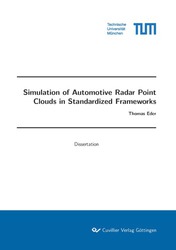| Areas | |
|---|---|
| Serie de libros (96) |
1378
|
| Nachhaltigkeit |
3
|
| Gesundheitswesen |
1
|
| Letra |
2364
|
| Ciencias Naturales |
5406
|
| Matemática | 229 |
| Informática | 319 |
| Física | 980 |
| Química | 1363 |
| Geociencias | 131 |
| Medicina humana | 243 |
| Estomatología | 10 |
| Veterinaria | 108 |
| Farmacia | 147 |
| Biología | 835 |
| Bioquímica, biología molecular, tecnología genética | 121 |
| Biofísica | 25 |
| Nutrición | 45 |
| Agricultura | 1004 |
| Silvicultura | 201 |
| Horticultura | 20 |
| Ecología y conservación de la tierra | 148 |
| Ciencias Ingeniería |
1793
|
| General |
98
|
|
Leitlinien Unfallchirurgie
5. Auflage bestellen |
|
Erweiterte Suche
Simulation of Automotive Radar Point Clouds in Standardized Frameworks (Tienda española)
Thomas Eder (Autor)Previo
Lectura de prueba, PDF (1,1 MB)
Indice, PDF (38 KB)
The simulation of the vehicle’s environmental sensors, the so-called sensor simulation, is crucial for testing and validating autonomous driving. Automobile manufacturers are increasingly focusing on a standardized architecture with a high level of abstraction. In order to simulate the sensors, such as radar sensors, most realistically on a point cloud level, data-based methods are used in many cases. In general, and specifically in case of radar sensors, there are still challenges to be faced. Therefore, four research questions are addressed:
Is it possible to generate synthetic training data for data-based models? Which statistical approaches are suitable to simulate radar point clouds and how shall their learning capacities be evaluated? Is there a modeling approach to circumvent the disadvantages of statistical modeling? How to tackle the statistical nature of radar sensors during validation?
Die Simulation der Umfeldsensoren des Fahrzeugs, die sogenannte Sensorsimulation, ist für Test und Absicherung des autonomen Fahrens entscheidend. Die Automobilhersteller setzen dabei zunehmend auf eine standardisierte Architektur mit hohem Abstraktionsgrad. Um die Sensoren, wie z.B. Radarsensoren, möglichst realitätsnah auf Punktwolkenebene zu simulieren, werden in vielen Fällen datenbasierte Methoden eingesetzt. Im Allgemeinen und speziell im Fall von Radarsensoren gilt es noch immer zahlreiche Herausforderungen zu meistern. Daher werden in dieser Arbeit vier Forschungsfragen behandelt:
Können synthetische Trainingsdaten für datenbasierte Modelle generiert werden? Welche statistischen Ansätze sind geeignet, um Radar-Punktwolken zu simulieren und wie können die Ansätze bewertet werden? Gibt es einen Modellierungsansatz, um Nachteile der statistischen Modellierung zu umgehen? Wie kann die statistische Natur bei der Validierung berücksichtigt werden?
| ISBN-13 (Impresion) | 9783736975361 |
| ISBN-13 (E-Book) | 9783736965362 |
| Formato | A5 |
| Idioma | Inglés |
| Numero de paginas | 126 |
| Laminacion de la cubierta | Brillante |
| Edicion | 1. |
| Lugar de publicacion | Göttingen |
| Lugar de la disertacion | München |
| Fecha de publicacion | 24.11.2021 |
| Clasificacion simple | Tesis doctoral |
| Area |
Informática
Ingeniería automotriz Ingeniería eléctrica |
| Palabras claves | Automatisiertes Fahren, automated driving, Autonomes Fahren, autonomous driving, Fahrerassistenzsysteme, driver assistance systems, Simulation, simulation, Radarsimulation, radar simulation, datenbasierte Modellierung, data based modeling, Sensorsimulation, sensor simulation, Punktwolkensimulation, point cloud simulation, standardisierte Simulationsumgebung, standardized simulation framework, Open Simulation Interface, Open Simulation Interface, Validierung, validation, Modellvalidierung, model validation, konsistenz, consistency, Radarpunktewolke, radar point cloud, statistische Modellierung, statistical modeling, hypothesentestbasierte Validierung, hypothesis test based validation, statistische Validierung, statistical validation, Test und Absicherung, test and validation, simulationsbasiertes Testen, simulation based testing, simulationsbasierte Absicherung, simulation based validation, Kerndichteschätzung, kernel density estimation, Punktwolkenverteilung, point cloud distribution, künstliche neuronale Netze, artificial neural networks, generative neuronale Netze, generative neural networks, Variational Autoencoder, Variational Autoencoder, Generative Adversarial Networks, Generative Adversarial Networks, Raytracing-basierte Radarsimulation, ray tracing based radar simulation, Fehleranalyse, error analysis, Mehrfachreflexionen, multiple reflections, Fehlerfortpflanzung, error propagation, Strahlaufweitung, beam expansion, Reflexionen an gekrümmten Oberflächen, reflections on curved surfaces, szenarienbasierte Validierung, scenario based validation, positionsbasierte Validierung, position based validation, Doppler-Effekt, Doppler-effect, Geschwindigkeitsverteilung, velocity distribution), Mikro-Doppler-Effekt, micro-Doppler effect, Mikro-Doppler-Signatur von Felgen, micro-Doppler signature of rims, hybrides Radarsensormodell, hybrid radar sensor model, Raycasting-basiertes Sensormodell, ray casting based sensor model, Lichtgeschwindigkeit, speed of light, Abtastfrequenz |








